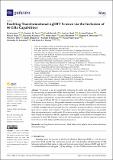| dc.contributor.author | Issaoun, Sara | |
| dc.contributor.author | Pesce, Dominic W. | |
| dc.contributor.author | Roelofs, Freek | |
| dc.contributor.author | Chael, Andrew | |
| dc.contributor.author | Dodson, Richard | |
| dc.contributor.author | Rioja, María J. | |
| dc.contributor.author | Akiyama, Kazunori | |
| dc.contributor.author | Aran, Romy | |
| dc.contributor.author | Blackburn, Lindy | |
| dc.contributor.author | Doeleman, Sheperd S. | |
| dc.contributor.author | Fish, Vincent L. | |
| dc.contributor.author | Fitzpatrick, Garret | |
| dc.contributor.author | Johnson, Michael D. | |
| dc.contributor.author | Narayanan, Gopal | |
| dc.contributor.author | Raymond, Alexander W. | |
| dc.contributor.author | Tilanus, Remo P. J. | |
| dc.date.accessioned | 2023-02-10T16:19:32Z | |
| dc.date.available | 2023-02-10T16:19:32Z | |
| dc.date.issued | 2023-02-10 | |
| dc.identifier.uri | https://hdl.handle.net/1721.1/148019 | |
| dc.description.abstract | We present a case for significantly enhancing the utility and efficiency of the ngEHT by incorporating an additional 86 GHz observing band. In contrast to 230 or 345 GHz, weather conditions at the ngEHT sites are reliably good enough for 86 GHz to enable year-round observations. Multi-frequency imaging that incorporates 86 GHz observations would sufficiently augment the <inline-formula><math xmlns="http://www.w3.org/1998/Math/MathML" display="inline"><semantics><mrow><mo>(</mo><mi>u</mi><mo>,</mo><mi>v</mi><mo>)</mo></mrow></semantics></math></inline-formula> coverage at 230 and 345 GHz to permit detection of the M87 jet structure without requiring EHT stations to join the array. The general calibration and sensitivity of the ngEHT would also be enhanced by leveraging frequency phase transfer techniques, whereby simultaneous observations at 86 GHz and higher-frequency bands have the potential to increase the effective coherence times from a few seconds to tens of minutes. When observation at the higher frequencies is not possible, there are opportunities for standalone 86 GHz science, such as studies of black hole jets and spectral lines. Finally, the addition of 86 GHz capabilities to the ngEHT would enable it to integrate into a community of other VLBI facilities—such as the GMVA and ngVLA—that are expected to operate at 86 GHz but not at the higher ngEHT observing frequencies. | en_US |
| dc.publisher | Multidisciplinary Digital Publishing Institute | en_US |
| dc.relation.isversionof | http://dx.doi.org/10.3390/galaxies11010028 | en_US |
| dc.rights | Creative Commons Attribution | en_US |
| dc.rights.uri | https://creativecommons.org/licenses/by/4.0/ | en_US |
| dc.source | Multidisciplinary Digital Publishing Institute | en_US |
| dc.title | Enabling Transformational ngEHT Science via the Inclusion of 86 GHz Capabilities | en_US |
| dc.type | Article | en_US |
| dc.identifier.citation | Galaxies 11 (1): 28 (2023) | en_US |
| dc.contributor.department | Haystack Observatory | |
| dc.identifier.mitlicense | PUBLISHER_CC | |
| dc.eprint.version | Final published version | en_US |
| dc.type.uri | http://purl.org/eprint/type/JournalArticle | en_US |
| eprint.status | http://purl.org/eprint/status/PeerReviewed | en_US |
| dc.date.updated | 2023-02-10T14:28:46Z | |
| dspace.date.submission | 2023-02-10T14:28:46Z | |
| mit.license | PUBLISHER_CC | |
| mit.metadata.status | Authority Work and Publication Information Needed | en_US |
